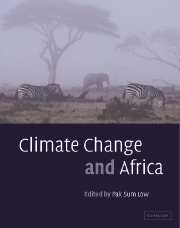Book contents
- Frontmatter
- Contents
- Notes on contributors
- Peer reviewers
- Editor's note
- Foreword
- Foreword
- Foreword
- Foreword
- Preface
- Preface
- Preface
- Preface
- List of abbreviations
- List of SI prefixes
- List of unit abbreviations
- List of chemical formulae
- Part I Science
- Part II Sustainable energy development, mitigation and policy
- Part III Vulnerability and adaptation
- 18 Potential impacts of sea-level rise on populations and agriculture
- 19 Sea-level rise and coastal biodiversity in West Africa: a case study from Ghana
- 20 The impacts of ENSO in Africa
- 21 Climate policy implications of the recent ENSO events in a small island context
- 22 El Niño causes dramatic outbreak of Paederus dermatitis in East Africa
- 23 The role of indigenous plants in household adaptation to climate change: the Kenyan experience
- 24 Requirements for integrated assessment modelling at the regional and national levels in Africa to address climate change
- 25 Climate and disaster risk reduction in Africa
- Part IV Capacity-building
- Part V Lessons from the Montreal Protocol
- Index
18 - Potential impacts of sea-level rise on populations and agriculture
Published online by Cambridge University Press: 10 December 2009
- Frontmatter
- Contents
- Notes on contributors
- Peer reviewers
- Editor's note
- Foreword
- Foreword
- Foreword
- Foreword
- Preface
- Preface
- Preface
- Preface
- List of abbreviations
- List of SI prefixes
- List of unit abbreviations
- List of chemical formulae
- Part I Science
- Part II Sustainable energy development, mitigation and policy
- Part III Vulnerability and adaptation
- 18 Potential impacts of sea-level rise on populations and agriculture
- 19 Sea-level rise and coastal biodiversity in West Africa: a case study from Ghana
- 20 The impacts of ENSO in Africa
- 21 Climate policy implications of the recent ENSO events in a small island context
- 22 El Niño causes dramatic outbreak of Paederus dermatitis in East Africa
- 23 The role of indigenous plants in household adaptation to climate change: the Kenyan experience
- 24 Requirements for integrated assessment modelling at the regional and national levels in Africa to address climate change
- 25 Climate and disaster risk reduction in Africa
- Part IV Capacity-building
- Part V Lessons from the Montreal Protocol
- Index
Summary
Keywords
Sea-level rise; extreme events; population density; scenarios
Abstarct
The chapter discusses some issues related to the potential impacts of sea-level rise (SLR) on coastal populations and agriculture. This is a study mostly based on global data at the countrywide (national) scale. Indirect effects of SLR, as well as the potential impact of extreme events, may be more significant than direct effects in the future. In the absence of an accepted methodology for building long-term scenarios, two approaches are explored: an analysis of a large database of extreme events that have occurred over the last 100 years, and an analysis of population statistics in relation to a national vulnerability index based on physiographic features and population density. Recent historical data are examined with a view to identifying trends that could be extrapolated into the twenty-first century. Despite the limitations of the data sets, some trends do emerge, but they do not necessarily point in the direction of greater property and population losses in the future owing to sea-caused disasters. Rather, they seem to indicate that difficulties – independent of the global changes – will be relatively larger on land than along the coasts, and that the major component of life and property losses is associated with levels of economic development. The ‘national vulnerability index’ confirms that vulnerability – if considered at the scale of the globe – varies considerably, over several orders of magnitude. In addition, the index exhibits a marked positive skew.
- Type
- Chapter
- Information
- Climate Change and Africa , pp. 191 - 203Publisher: Cambridge University PressPrint publication year: 2005
- 1
- Cited by



